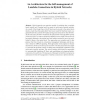Free Online Productivity Tools
i2Speak
i2Symbol
i2OCR
iTex2Img
iWeb2Print
iWeb2Shot
i2Type
iPdf2Split
iPdf2Merge
i2Bopomofo
i2Arabic
i2Style
i2Image
i2PDF
iLatex2Rtf
Sci2ools
IFIP
2007
Springer
2007
Springer
An Architecture for the Self-management of Lambda-Connections in Hybrid Networks
Hybrid networks are networks capable of switching data at multiple levels (optical and IP packet level) by means of multi-service optical switches. As a result of that, huge flows at the IP-level may be moved to the optical-level, which is faster than the packet-level. Such move could be beneficial since congested IP networks could be off-loaded, leaving more resources for other IP flows. At the same time, the flows switched at the optical-level would get better Quality of Service (QoS). In order to achieve this beneficial move, huge IP flows have to be properly detected at the packet-level and lambda-connections are to be established for them at the optical-level. Two approaches are currently used for that purpose: the first is based on conventional management techniques and the second is based on GMPLS signaling. Both approaches mostly depend on human intervention, which can be error prone and slow. The idea proposed in this paper to overcome this problem consists of adding se...
| Added | 08 Jun 2010 |
| Updated | 08 Jun 2010 |
| Type | Conference |
| Year | 2007 |
| Where | IFIP |
| Authors | Tiago Fioreze, Remco van de Meent, Aiko Pras |
Comments (0)

